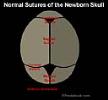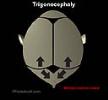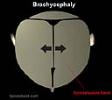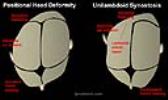II. Definition
IV. Causes
- Idiopathic
- Hyperthyroidism
- Rickets
- Hyperparathyroidism
- Underlying genetic disorder
- Apert's Syndrome
- Crouzon's Syndrome
- Pfeiffer's Syndrome
V. Risk Factors
- Caucasian mother
- Advanced maternal age
- Male infant
- Maternal Tobacco Abuse
- Mother living at high altitude
- Fertility treatments
- Paternal occupation in agriculture, forestry, mechanics
- Maternal exposure to nitrosatables
VI. Evaluation
- Observe head shape for abnormality
- Asymmetry
- Elongated, broad, or triangular shape
- Ridging at Suture lines beyond first week of life
- Check Head Circumference
- Evaluate for Hydrocephalus and Microcephaly
- Evaluate for other musculoskeletal abnormalities
- Spine, fingers, and toe abnormalities
VII. Metopic Synostosis (Trigonocephaly)
- Images
- Pathophysiology
- Metopic Suture (sagittal plane of forehead) closure
- Characteristics
- Forehead elongates
- Anteroposterior distance increases
- Forehead less rounded and more pointed
- Ridge forms down center of frontal forehead
- Eyes appear closer together
- Eyebrows appear pinched
- Forehead elongates
- Management
- Surgery to increase anterior cranial volume
VIII. Bicoronal Synostosis (Brachycephaly)
- Images
- Pathophysiology
- Coronal Suture closure
- Anterior to Parietal Bones (Passes between ears)
- Metopic Suture may also be affected
- Coronal Suture closure
- Characteristics
- Skull widens and becomes nearly circular in shape
- Forehead flattens
- Associated Conditions
- Crouzon's Syndrome
- Apert's Syndrome
- Management
- Surgery to increase anteroposterior length
IX. Unilateral Coronal Synostosis (Frontal Plagiocephaly)
- Images
- Pathophysiology
- Unilateral coronal Suture closure
- Characteristics
- Asymmetric flattening of affected side of forehead
- Eyebrow appears to wink (flat on affected side)
- More evident by looking at child in mirror
- Forehead elongates
- Anteroposterior distance increases
- Forehead less rounded and more pointed
- Asymmetric flattening of affected side of forehead
- Differential Diagnosis
- Similar to Trigonocephaly but asymmetric
X. Occipital Plagiocephaly (Unilambdoid Synostosis)
- Images
- Pathophysiology
- Unilateral lambdoid Suture closure
- Lamboid Suture sits behind Posterior Fontanelle
- Characteristics
- Asymmetric flattening of affected side of occiput
- Similar to Frontal Plagiocephaly but affects occiput
- Occiput may appear more pointed
- Differential Diagnosis
- Positional Head Deformity may give similar appearance
XI. Sagittal Synostosis (Scaphocephaly)
- Images
- Epidemiology
- Most common Craniosynostosis form (1 in 4200 births)
- More common in boys (3x)
- Pathophysiology
- Sagittal Suture (between Parietal Bones) closure
- Characteristics
- Skull elongates to become long and narrow
- Management
- Strip craniectomy (now performed via endoscopy) or
- Cranial vault remodeling
XII. Imaging
- Skull films (Anteroposterior and lateral views)
- Cranial Ultrasound (if Anterior Fontanelle open)
- Signs of Increased Intracranial Pressure
- Ventricular dilatation
- May also be effective in Lambdoid Suture evaluation
- Signs of Increased Intracranial Pressure
- CT with 3D Reconstruction or MRI Brain
- Sutures more accurately defined that plain XRay
- Evaluate for coexisting intracranial abnormalities
- Hydrocephalus
- Corpus callosum agenesis
XIII. Complications: Untreated Craniosynostosis
- Increased Intracranial Pressure
- Facial asymmetry
- Malocclusion
- Orbit asymmetry (associated with Strabismus)
XIV. Management
- Identify and refer for surgery at earliest possible age






